SUBJECTS
GRADE
Show Results
Owls Are a Hoot
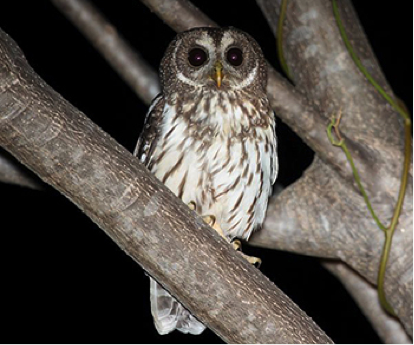
Lesson Summary
- Read poetry, then reflect on and analyze structure, word choice, and punctuation.
- Create a poem that reflects creative word choices and uses another perspective.
Lesson Plan and Procedure
Lesson Key Facts
- Grade(s): 5
- Subject(s): Drama, English Language Arts
- Duration of lesson: 55 minutes
- Author(s): Teresa Dayley Love
Preparation
Make sure you have all the lesson materials and enough space in the room to move. Write the poems on the board or on a piece of paper that you can mark on. Awareness of cultural beliefs and customs that students in your classroom have in relation to owls would enhance this lesson.
Warm-Up/Hook
Read “On Our Way” by Eve Merriam. Encourage the students to close their eyes and visualize the actions in the poem. Read it again and have them act it out as you read.
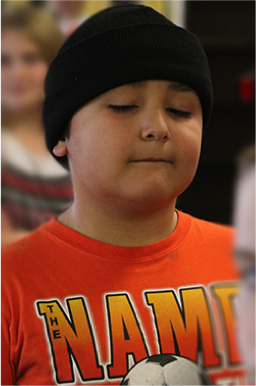 Review meter, rhyme, emotional memory, sense memory, creativity, and originality with the students. This is also a good opportunity to identify similes found in the poem.
Review meter, rhyme, emotional memory, sense memory, creativity, and originality with the students. This is also a good opportunity to identify similes found in the poem.
Note: Saying the words aloud with color and emphasis helps students (especially auditory learners) to connect with the words and lays the groundwork for acting with the full body later. Doing it as a full class helps the students hear others' creative choices and lets them experiment vocally in the anonymity of a full group. It's important that this lesson be as much about saying words out loud to make meaning as it is about full-body acting. We are connecting students to printed text here, a skill important to drama.
Tell the students that today they get to create their own poem and act it out. Remind them that poets need something to write about.
Show pictures of owls to introduce the poem “Night Creature” by Lillian Moore.
Teacher: This is a poem you could imagine being written by an owl, if owls could write.
Read the poem.
Communicating Meaning
Engage the students in analyzing how the poet would like the poem read aloud.
Have them notice the phrase “quiet breathing, day bustles, and night rustles” and discuss how this would be expressed by a reader. Have the students work together to come up with an interesting way to say the word. Gather a few ideas and then mark the words in a way that will help the students recall the aesthetic decisions they made for when they speak the text as a group.
Example:
Teacher: Oh, so if we want to remember to say this word loudly and quickly, how should we mark it? All caps? Red marker? Good! That will remind us.
Note the term “tree talk” and ask the students what it could refer to. Do some modeling of how the word can be conveyed.
Teacher: "Tree talk." Of course, that's just the way I said it. Who has a different idea? (Allow students to share their ways of saying the word.) You are making me really hear that with your voices. I can hear the rustling, windy sort of sound by the way you say it. How would you embody the term? Would showing help to communicate your meaning? Let's all stand up behind our desks. When I give you the cue, everyone will not only say "tree talk" but show me "tree talk" as well.
Highlight a few different ways students answer the challenge. This gives the idea that there are many right answers, and it also sets up the acting component that will happen later. At this point, introduce the idea of point of view.
Teacher: Now, instead of being the tree talk, how about you show me what it looks like to observe and hear the "tree talk." Act like you are watching and listening to the tree talk.
Recognize the pattern of quiet, then loud, and then quiet again in the stanzas. Pay attention to punctuation and its use and impact on how sentences are read. Examine the imagined word glare-y. What could that mean? How could that be expressed?
Continue until you feel enough elements of the poem have been discussed in ways that the students can use to make good creative choices. Make sure the students can see and note the aesthetic choice markings that have been made to the poem. Have the students choral-speak the poem, encouraging them to increase the quality of their vocal expression. Have the whole group act out some, if not all, of the poem.
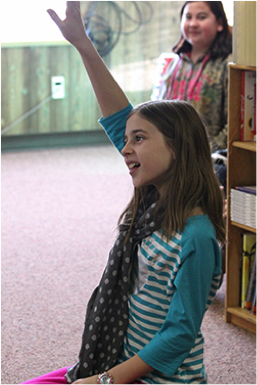 Introduction
Introduction
Lead a buzz session about owls. Have the students share and discuss any knowledge they have about owls. If students focus too much on one aspect, refocus the conversation to cover more information.
Instruction/Rehearsal
On the whiteboard, write the following:
O
W
L
S
Teacher: Get into groups of two or three and create a poem about owls using these letters. Think about words that start with these letters and that remind you of owls. Brainstorm and write the words on your paper. Look at pictures and listen to sounds of owls for inspiration. Plan how you will read and act this out as a group.
Encourage students to play with punctuation in their short poems.
Example:
Owls are cool!
Owls are like Wolves, hunting in the night.
They look like they have Lights in their eyes.
Owls eat Slithering snakes!
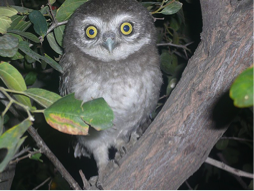

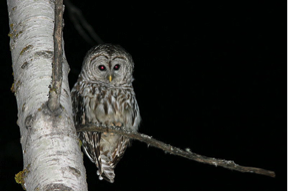
As part of their rehearsal, have the students analyze their poem and recite it as group, paying attention to the reflection ideas from “Night Creatures.” Have the students recite their poem again and act it out. Encourage students to do some thinking before they act, paying attention to how they show elements of their poem.
Activity/Performance
Have the groups read the poems and act them out for the class. Perhaps have them write out the poems on the board or on paper so everyone can see how they used O, W, L, and S in the poem.
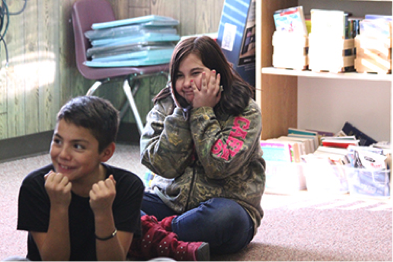

Conclusion
Facilitate a discussion regarding not only the choice of the words but also how the words were said and embodied to communicate meaning to the audience. You need to help the audience "read" the performances as texts. Discuss what they learned about the process of writing poetry from this activity.
Teacher: What was it like writing your poem and working as a group to read and act it out? How did you experiment with narration and points of view? Were you students acting as the owl or as someone watching the owl? How did this help you become better writers?
Encourage them to comment on someone else’s poem along with theirs.
Possible Extension Activity
Have the groups continue to work on their poems. Give them the following challenges:
Teacher: Can you change the sentences so that they rhyme without changing the meaning? Can you change the meter? Are there any imagined words you could add? Can you change the meaning by altering the punctuation?
Assessment
- Did students analyze the poem and express it vocally with depth and specificity?
- Did students create a group poem?
- Did students demonstrate creative choices with the ways they expressed their poems and acted them out?
Learning Objectives
- Determine the theme of a story, drama, or poem from text details.
- Determine how the narrator or speaker in a poem reflects upon a topic.
- Summarize a text.
- Develop student imagination.
- Respond in-character during a scene.
- Communicate meaning through body and voice.
- Demonstrate audience skills.
- Assign roles and work as a group.
Utah State Board of Education Standards
This lesson can be used to meet standards in many grades and subject areas. We will highlight one grade’s standards to give an example of application.
Grade 5 English Language Arts
Standard 5.R.10: Analyze how a series of chapters, scenes, or stanzas fits together to provide the overall structure of a literary text. (RL)
Standard 5.R.11: Explain how a narrator’s or speaker’s point of view influences how events are described. (RL)
Standard 5.W.4: Conduct short research projects to craft an argument or answer a question.
- Gather, summarize, and paraphrase information and provide a list of relevant sources.
- Elaborate to demonstrate understanding of the topic under investigation.
- Interact and collaborate with others throughout the writing process.
Grade 5 Drama
Standard 5.T.CR.1: Develop imagination to create artistic ideas and work.
Standard 5.T.P.3: Observe, listen, and respond in character to other actors throughout a scripted or improvised scene.
Standard 5.T.P.4: Communicate meaning using the body through space, shape, energy, and gesture.
Standard 5.T.P.5: Communicate meaning using the voice through volume, pitch, tone, rate, and clarity.
Standard 5.T.R.1: Demonstrate audience skills of observing attentively and responding appropriately.
Equipment and Materials Needed
- Whiteboard/chalkboard and appropriate writing instruments
- Pictures and sound clips of owls (optional)
- Poems
- “On Our Way” by Eve Merriam
- “Night Creature” by Lillian Moore
Additional Resources
- Kenn Nesbit, “Rhythm in Poetry—The Basics,” Kenn Nesbit’s Poetry4kids.com, https://www.poetry4kids.com/news/rhythm-in-poetry-the-basics/.
- “6 Tips for Writing a Poem about Memories,” Power Poetry, http://www.powerpoetry.org/resources/writing-memory-poems.
- Howe, Christy. “Let’s Get Creative,” Creative Classroom Tools, http://creativeclassroomtools.blogspot.com/2014/07/lets-get-creative.html.
Image References
Image 1: Dominic Sherony, originally posted to Flickr as Mottled Owl, CC BY-SA 2.0, https://commons.wikimedia.org/w/index.php?curid=6120669
Images 2, 3: James Huston
Image 4: Syedadnanshamsi, CC BY-SA 4.0, https://commons.wikimedia.org/w/index.php?curid=58814150
Image 5: Kristina Servant, https://www.flickr.com/photos/xkristinax/9649002129/, CC BY 2.0, https://commons.wikimedia.org/w/index.php?curid=32784822
Image 6: Wing-Chi Poon, CC BY-SA 2.5, https://commons.wikimedia.org/w/index.php?curid=431165
Images 7, 8: James Huston

www.education.byu.edu/arts/lessons
 Download
Download